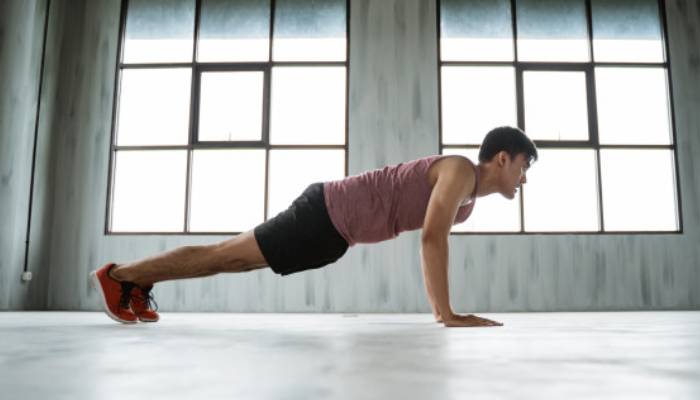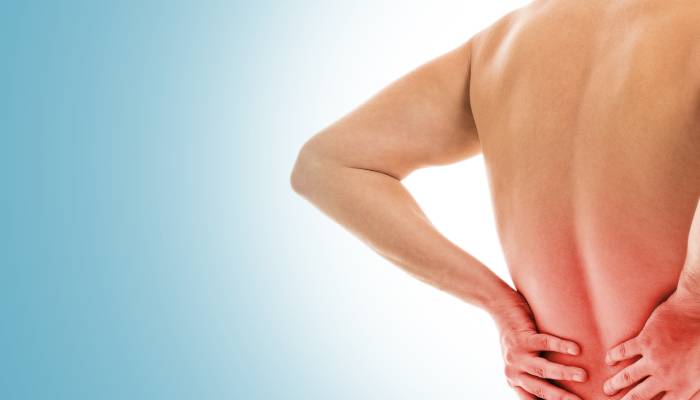There’s no magic number of Pushups that will give you the above advantages. Consider pushing yourself instead. Zeltia recommends beginning with eight reps, then changing the amount based on how demanding the set feels.
The target, he says, is to feel hard enough for the last two reps that you’re struggling to complete them, but not so challenging that you can’t sustain good shape.
Should You Do Pushups Every Day?
Zeltia recommends doing Pushups one or three days a week in terms of duration. While daily Pushups competitions are common, both he and Mansour are not big fans of regular Pushups, as that pace probably won’t give the body the time it needs to relax and heal properly.
If yesterday’s set left you feeling tired, wait until the exhaustion subsides before you get back to it. Mansour advises listening to your body to decide how much to do Pushups.
Before a cardio exercise, you should deal with Pushups or do them after weight lifting, says Zeltia. Or as their mini exercise, you should break out sets of Pushups.
[Worth Reading: 5 Best Travel Yoga Mats ]
What Happens If I Do Pushups Every Day?

For building upper body muscle, conventional Pushups every day are helpful. They work the triceps, pectoral muscles, and shoulders. They will also reinforce the lower back and heart by working (pulling in the abdominal muscles when performed with proper shape.
What happens if I do pushups every day? For building muscle, Pushups are a fast and productive workout. They can be performed from almost anywhere and do not need any machinery.
When you’re looking for a consistent workout regimen to follow, doing Pushups every day can be successful. If you do Pushups daily, you will find increases in upper body power.
Try to bring diversity to the sorts of Pushups you perform for the best performance. A “Pushups challenge” can also be followed, where you progressively raise the number of Pushups each week. In two months, you can work up to 100 reps.
What are the Benefits of Doing Everyday Pushups?

Increased Joint Support
Pushups are particularly good at strengthening the muscles around the joints of the shoulder. It is the duty of the muscles and tendons in the shoulder region to hold the upper arm bone in the shoulder socket.
However, to build up enough strength in the muscles, it is necessary to increase the number of Pushups progressively. Overloading weak muscles can result in injuries to the muscles and tendons.
[Worth Reading: 5 Best Yoga Mats for Carpets ]
Increased Muscle Tone and Strength
There are many distinct Pushups variations, and the muscles are triggered in various ways by each form.
The following Pushups differences were investigated in a small 2015 sample involving eight participants and compared their effects on various muscle groups:
Standard Pushups (SP): The hands are separate from the shoulder width and in contact with the shoulders directly. With the thighs, the upper torso, or trunk, lines up, and the body stays straight throughout.
Complete pushup: Double that of the SP, the distance between the paws.
Narrow Pushups (NP): With the thumb and forefinger on each hand touching, the hands are below the middle of the breastbone, or sternum.
Forward Pushups (FP): The hands are 20 centimeters (cm) away from the breadth of the shoulder in front of the shoulders.
Backward Pushups (BP): The breadth of the shoulder separates the limbs but is 20 cm below the shoulders.
The study discovered the following:
- The most massive activation of the triceps and pectoralis major muscles, or pecs, was the product of NPs.
- The highest stimulation of the abdominal and back muscles culminated in FPs and BPs.
- BPs activate the highest number of muscle groups overall.
- The authors conclude that for improving upper body condition and strength, BPs may be the most effective Pushups variation.
- NPS is ideally suited to individuals looking to improve their triceps and pecs in height, color, or strength.
Enhanced Cardiovascular Health
Many studies have related muscle power to a decline in the risk of cardiovascular disease.
The relation between the number of Pushups a person can do and their risk of having a cardiovascular health problem ten years later was explored in a 2020 report. In the sample, a total of 1,104 healthy, middle-aged males took part.
The researchers found a substantial disparity between two classes of males; those who were able to do more than 40 Pushups and those who were able to perform less than 10.
Males in the 40+ Pushups category were 96 percent less likely than males in the 10- Pushups group to have encountered a cardiovascular problem.
It is important to note, however, that only healthy, middle-aged males were included in this analysis. To decide whether these correlations are the same for women and for individuals who are older or inactive, further studies are required.
[Worth Reading: 5 Best Yoga Mats ]
Improved Power of the Upper-Body
The reality that Pushups seriously test your upper half is no shocker. After all, you are twisting your arms to lower and raise your whole body.
“Pushups are a great upper-body strengthened,” says Stephanie Mansour, a licensed personal trainer based in Chicago. This is because the whole upper half is essentially functioning, including the front of your chest, both the front and back of your arms (aka biceps and triceps), shoulders, and upper back, she notes.
In these places, gaining power will make some day-to-day tasks feel a little better, such as carrying a hefty bag of food or lifting a suitcase into an overhead bin.
Another advantage: Pushups strike several different muscle groups at once relative to other upper-body exercises that target only one particular muscle group, such as bicep curls, for instance, which home on (surprise, surprise) the biceps, making them an easy, efficient exercise to increase upper-body strength overall.
Improves Posture
Many of us live our days with hunched shoulders and a rounded back, hallmarks of bad posture due to today’s tech-tethered environment. Pushups, if done right, by showing our bodies proper positioning, Zeltia notes, will help counteract this.
He describes that proper Pushups require engaging the scapula and rhomboids (two mid-back muscles that are usually underworked) without depending too often on the muscles on the top of the shoulders and neck (which are usually overused by many of us in daily life anyway, particularly when we are stressed).
Healthy posture also comes from core strength and consistency of quality, and Pushups will undoubtedly help with that as described.
Supports Strong Bones
Other than strengthening muscles, Pushups do more to challenge the spirit. As they are a weight-bearing move, Pushups can also encourage healthy bone health.
According to the National Institutes of Health, weight-bearing movements can help develop solid bones and delay bone loss.
[Worth Reading: 5 Cheap Yoga Mats ]
Improved Core Strength and Stability
But Pushups aren’t just about strength in the upper body. “can be a full-body workout if done correctly, “Pushups Progression” Pushup Progression “can be a full-body workout if done correctly.
He identifies the Pushups as a successful move of “bang for your buck” as it operates concurrently with several different joints and muscles.
Core strength and endurance are a significant part of the total-body function. Pushups are a perfect way to balance and reinforce the heart when appropriately done, says Zeltia, who describes “core” as literally all aspects of your body that are not your head, arms, or legs.
That implies that your rectus abdominis (aka “abs”) is not only the heart but also involves several other muscles in your midsection.
And while some core moves focus mostly on the abs (looking at you, crunches), some of the lesser-known muscles in your core are activated by adequately done Pushups, such as transverse abdominis (the deepest core muscle that helps stabilize the spine), multifidus (a collection of tiny muscles running along the spine), and others.
You’re making the whole unit of the heart grow more robust and more stable by attacking these other core muscles. A better core unit would make it smoother in life since the core is essentially the powerhouse of the body and a vital part of the movements we perform in so many different situations.
This entails practices both in the gym (whether you squat or sprint or lift weights) and in daily life (from walking or carrying groceries to picking up a child).
Are There Risks of Doing Pushups Daily?

Pushups can increase the risk of some injuries, as with most exercises.
The use of an incorrect procedure results in numerous accidents. If they are confused about how to do various types of Pushups, people can speak to a fitness coach.
The benefits of exercise, generally tend to outweigh the risks. Any possible dangers of doing regular Pushups, however, include:
We are Reaching a Fitness Plateau.
People who repeat the same workout every day will find that with time, it gets less and less complicated. People refer to this as a plateau of fitness. It reveals that the muscles are not forming anymore.
People can integrate a wide variety of workouts into their workout regimen to prevent hitting a fitness plateau. Doing so can allow several different sets of muscles to activate.
People involved in muscle maintenance can benefit from the application of aerobic exercise. A 2014 study showed that individuals who do a physical activity over their lifetime appear to sustain greater muscle mass.
Ideally, the following kinds of exercise can also be integrated into a rigorous fitness routine:
- Core Growth Core
- Balance Teaching Training
- Stretch
The Back Pain

The stimulation of the lower back muscles is increased by such Pushups variants, such as the BP and the FP. This could lead to pain and stiffness in the lower back.
Pushups often cause the intervertebral joints in the spine to be strained briefly. The point at which two parts of the backbone come together is the intervertebral joint.
Each part of the backbone is divided by a cushion of tissue called an intervertebral disk. Excessive weight-bearing movements, resulting in discomfort and stiffness, will lead to wear and tear of these disks.
Before integrating Pushups into their exercise regimen, people with existing back problems should speak to a doctor.
The Wrist Pain

When doing weight-bearing movements such as Pushups, certain persons feel pain in the wrists. When a human bends his hand backward, much pain happens in the back portion of the wrist.
A 2018 study showed that in reaction to weight carrying, 84 percent of persons feeling discomfort along the back of the wrist have a functional abnormality within the wrist. Around 76 percent of these cases were due to a tiny cyst of the ganglion. A partial ligament rupture was the second most prevalent cause of pain.
If these anomalies are the outcome of repetitive weight-bearing workouts is not clear.
Nevertheless, people who feel wrist pain should see a doctor during Pushups. They will provide instructions on how to help the wrist during exercise. Alternatively, a particular workout method may be suggested by a practitioner.
Elbow Injury

The effects of Pushup speed on elbow joints were researched in a 2012 report. Three distinct Pushups speeds were measured by the researchers: fast, medium, and slow.
The study showed that higher pushup velocities resulted in higher stresses on the elbow joints, ligaments, and other tissues around them. They concluded that faster Pushups could increase the likelihood of damage to these systems.
The study also found that more significant muscle activity resulted in slower Pushups rates.
Overall, these results show that slower Pushups are smoother and more likely to lead to better development of muscles.
How to Do a Pushups

- With your elbows over your wrists and your feet under your legs, get on all fours. Ensure that your elbows are as wide open as your hips.
- Walk several inches forward with your knees, then turn your body forward so that your elbows are again over your wrists. You’ll now have your hips in front of your feet. When you press down into your hands, hold your fingers together and extend them out.
- Pull your belly button into your spine from here and tuck your toes below to lift your knees off the ground and come into a high spot on the plank.
- Be sure that your heels are over your toes directly, and your wrists are also behind your shoulders. Your collar should be in line with your spine, and your shoulders should be rolled back and down away from the ears (don’t tuck your chin or crane your head up). Made sure you match your upper back and glutes. Squeeze up the glutes and quads. The starting place is this.
- Breathe in at a 45-degree angle to your sides as you bet your knees, and drop yourself back to the ground, pressing your shoulder blades together and keeping your spine and quads braced.
- Lower yourself for two or three counts as far down as you can (even if it’s only a few inches) while still keeping decent shape, don’t let your hips sag or your ass hike up. From the top of your head to your feet, your body should be in one long straight line.
- Pressure down into your hands at the bottom of the movement and breathe out as you push yourself back up to the starting point over one count. That’s one rep.
Tips
When doing a Pushups
- Hold your back straight and engaged with your heart.
- Your rear needs to be down, not lifted.
- The body should create a straight line. Don’t curve your back, and don’t let your body collapse.
To make sure the type is right, ask a mate. To secure your wrists, keep your hands tightly planted on the ground or a mat as well. Start on your knees if this is too complicated.
How to Start Doing Daily Pushups
Begin doing Pushups every day by “testing” how many you can do with the right form at one time (or within one minute). To build up power, slowly raise the amount you practice every day or every other day.
Start with adjusted Pushups on your knees or against a wall if Pushups are too challenging at first if you’re a novice.
Top 13 Different Types Of Push-Ups
Pushups Variations
Pushups are a demanding move, and if you’re not yet able to do them as mentioned above, it’s OK. A typical regression is collapsing to your knees and from there doing Pushups. This change dramatically decreases the strength needs of the body while also exercising the same muscles, says Mansour.
When performing the following combinations, find Pushups more difficult. It would help if you also did Pushups on your feet or hands on a medicine ball for an extra challenge.
Rolling Pushups
- Conduct one conventional Pushup.
- Raise and roll the left arm into a side plank. Continue rolling after a few seconds, putting your left arm on the ground so that you wind up on a reverse plank.
- Lift the right arm and roll the left limb into a side plank. Continue rolling after a few seconds, putting your right hand on the ground so that you end up in a plank stance again.
- Start again and head in the opposite direction with triceps Pushups.
- To commence, execute 5 to 10 repetitions. Focus on balancing your arms and shoulders with constant energy and having your hips raised throughout the whole dance.
Pushups with Hip Abduction
- Start with your arms slightly wider than your shoulders, in a high plank stance.
- Pick your right leg off the floor and shift it progressively farther forward than your hips during the whole workout, leaving it elevated. Your foot needs to flex.
- To lift the right leg off the ground, do Pushups.
- Perform 6 to 8 reps. Lower your right leg then and raise your left leg. Repeat your pass
Conclusion
What happens if I do pushups every day?
Every day, doing Pushups will help you develop upper body strength. But bear in mind, after a while, you’ll need to mix up the sorts of Pushups you do to continue to challenge your muscles.
If you choose to learn to do the workout regularly or multiple days a week for a Pushups challenge, try various styles of Pushups. The selection will keep your muscles guessing and help you overall get more fit.
READ THIS NEXT
Why Blood Pressure Drop During Exercise
How to Make Yourself Vomit Without it Hurting
How to Grow Beard on Cheeks Faster Naturally
Low Acid in Stomach Symptoms, Causes, Treatment
Is it Better to Sleep Without a Pillow
Shortness of Breath After Quitting Smoking

Comments are closed.